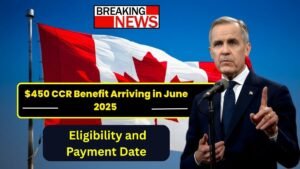If you’re a senior living in Canada or nearing retirement, there is some good news waiting for you this June 2025. Through a combination of Canada Pension Plan (CPP) and Old Age Security (OAS), you could receive up to $1,700 or even more in monthly payments. But how do you qualify? What do you need to know to maximize your benefits? Let’s dive deep into the details so you can make the most of your retirement income.
Understanding the $1,700 Payment Figure
The potential to receive $1,700 in June isn’t just a random number. It’s based on a combination of CPP and OAS benefits available to eligible Canadian seniors. Here’s a breakdown of the estimated maximum monthly amounts for June 2025:
- CPP (Canada Pension Plan): Up to $1,433.00
- OAS (Old Age Security) for Age 65–74: Up to $727.67
- OAS for Age 75+: Up to $800.44
So technically, a senior over 75 years old who qualifies for the maximum in both CPP and OAS could receive as much as $2,233.44 monthly. However, most retirees won’t hit that maximum due to varying contribution levels and individual circumstances. Still, the $1,700 mark is well within reach for many.
How Does CPP Work?

The Canada Pension Plan is a monthly, taxable benefit that replaces part of your income once you retire. It’s not automatic; you need to apply for it. Your monthly amount depends on how much and how long you contributed to CPP during your working years. The longer and more you contribute, the more you get.
For instance, someone who started working in their early 20s and made maximum contributions for 40+ years can expect to receive close to the maximum benefit of $1,433 per month. On the other hand, if you worked part-time or had career gaps, your CPP amount could be much lower.
It’s also worth noting that you can begin receiving CPP as early as age 60, but taking it early will reduce your monthly payments. Delaying CPP until age 70 increases your monthly amount by up to 42%, which can make a big difference in your later years.
What Is Old Age Security (OAS)?
OAS is different from CPP in one major way – it’s not tied to your work history or contributions. Instead, it’s a government-funded monthly benefit for seniors aged 65 and above who have lived in Canada for at least 10 years after turning 18.
Here are the maximum OAS amounts for June 2025:
- Age 65–74: $727.67/month
- Age 75 and older: $800.44/month
If your income is too high, however, your OAS may be clawed back. The clawback starts when your income exceeds $90,997, and the amount is reduced by 15% of the income above that threshold.
Boosting Your Benefits: Practical Tips
Want to make sure you’re getting the most from CPP and OAS? Here are a few practical tips:
- Delay Your CPP Payments – Waiting until you turn 70 to collect CPP can significantly boost your monthly income.
- Maximize Contributions – If you’re still working, contribute as much as possible to the CPP.
- Apply Early – Apply for both CPP and OAS at least 6 months before you want payments to start to avoid delays.
- Spousal Options – Pension sharing and survivor benefits can help couples maximize household retirement income.
Tax Considerations
Remember, both CPP and OAS are considered taxable income. If your total income is high, not only might you owe more taxes, but you could also face an OAS clawback.
To minimize this, consider:
- Income splitting with your spouse
- Contributing to an RRSP while you’re still working
- Withdrawing RRSPs in a tax-efficient way before age 71
These steps can help you reduce your taxable income and keep more of your OAS benefits.
Example Scenario: Meet Anne

Let’s take a look at a real-life example. Anne is 66 years old and recently retired. She contributed the maximum to CPP throughout her 40-year career. Here’s what her income looks like:
- CPP: $1,433/month
- OAS: $727.67/month
- Annual income: Around $25,000
Because her income is below the clawback threshold, Anne keeps her full OAS. Depending on her total income, she may even qualify for the Guaranteed Income Supplement (GIS), which could boost her monthly income further.
Common Mistakes to Avoid
Even with the best intentions, seniors sometimes make errors that cost them money. Avoid these pitfalls:
- Applying late and missing out on payments
- Starting CPP too early without needing it
- Forgetting to update banking details or addresses
- Ignoring the tax impact on your net income
Why CPP and OAS Are Important
These two programs form the financial foundation for millions of retired Canadians. While they may not fully replace your working income, they significantly ease the cost of living in retirement. In today’s economy, where inflation and housing costs continue to rise, every dollar counts.
Additionally, both CPP and OAS are adjusted annually to reflect inflation. While this helps, it doesn’t always keep up with real-world cost increases, which is why it’s important to also look into personal savings, pensions, or programs like GIS.
Conclusion
Getting up to $1,700 (or more) in CPP and OAS payments this June 2025 can make a real difference in your monthly budget. Understanding how these programs work, checking your eligibility, and applying smart strategies can help you receive what you deserve.
Don’t leave money on the table. Review your benefits, plan ahead, and consult a financial advisor if you need help. Retirement should be a time of relaxation and comfort – not financial stress. Make sure you’re making the most of what’s available to you.
FAQs
Q1. What is the $1,700 CPP Payment in June 2025?
A: The $1,700 CPP payment is a one-time Canada Pension Plan benefit boost or supplemental support aimed at eligible seniors. It’s intended to provide financial relief to retired individuals who rely on CPP during a time of rising living costs.
Q2. Is this $1,700 a regular monthly CPP payment?
A: No, this is not a regular monthly CPP benefit. The standard monthly CPP payments vary based on contributions. This $1,700 payment is likely a special one-time or adjusted benefit scheduled for June 2025.
Q3. Is this payment taxable?
A: Yes, CPP payments, including any additional or one-time benefits, are considered taxable income and may need to be reported when you file your taxes.
Q4. Do I need to apply for the $1,700 CPP payment?
A: No separate application is required if you are already enrolled in CPP. The Canada Revenue Agency (CRA) or Service Canada will automatically issue payments to eligible recipients.
Q5. When will the $1,700 payment be deposited?
A: The payment is expected to be deposited in June 2025, though the exact date will depend on the government’s confirmed benefit schedule and your banking setup (direct deposit vs. mailed cheque).


